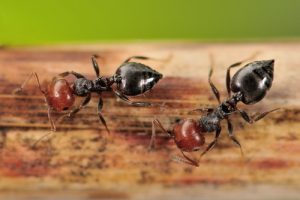Acrobat Ants Indoors
By Chris Williams on October 6, 2011.
Q. We have this tiny, black ant that has invaded our house in the last couple of weeks. My son got out his microscope kit and we could see that the ants have a heart-shaped abdomen. Can you tell what kind of ant it is from that?
A. Actually the heart-shaped abdomen is unusual and is a good clue. Could be the acrobat ant, Crematogaster spp. Take a second look and see if you also spot a pair of short spines on its thorax. This is one of a group of ants that tend aphids, mealybugs, and scale insects on plants, protecting them so they can feed on the “honeydew” the insects exude. In fall when the plants are declining and the aphids are dying, acrobat ants start foraging, looking for other food sources. This is often when they end up indoors.
There’s a good way to tell whether these are acrobat ants. They got their name because, when disturbed, they run holding their abdomen up over their back. They also emit a strong odor that smells like feces when disturbed. Acrobat ants are rather aggressive and can both bite and sting.
 Acrobat ants are becoming increasingly important as invaders inside structures. Your ants may just be foraging indoors from outside, or they may actually be nesting inside. Indoors, the acrobat ant often nests where there has been water damage to wood, especially inside wall voids. They are also found in wood that has already been damaged by carpenter ants, termites, or wood-boring beetles. Colonies are fairly small and they rarely do any significant damage to the wood.
Acrobat ants are becoming increasingly important as invaders inside structures. Your ants may just be foraging indoors from outside, or they may actually be nesting inside. Indoors, the acrobat ant often nests where there has been water damage to wood, especially inside wall voids. They are also found in wood that has already been damaged by carpenter ants, termites, or wood-boring beetles. Colonies are fairly small and they rarely do any significant damage to the wood.
Acrobat ants also nest in Styrofoam insulation behind siding. Outdoors, they nest under rocks, or tunnel into decayed logs, firewood, or trees.
Acrobat ants enter houses by trailing along the ground and following utility lines, wires, or tree branches to enter buildings under door thresholds or through any small opening, since they are only about 1/8 inch long.
Look for plants around your house that may be infested with aphids or other plant-sucking insects. Chances are, you will find the acrobat ant there, too. Often if you can eliminate the aphids or other plant pests, you will eliminate the acrobat ant as well. If the ants are foraging in from outside, trim branches and seal cracks where they are entering. Indoor control methods depend on whether the ants are nesting inside or not. Give us a call. One of our trained pest control technicians can answer that question and advise you as to what should be done. At Colonial, we do pests so you don’t have to!